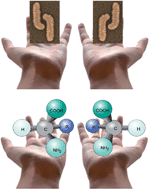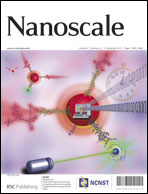The origin of off-resonance non-linear optical activity of a gold chiral nanomaterial†
Abstract
We demonstrate that engineered artificial gold chiral nanostructures display significant levels of non-linear optical activity even without plasmonic enhancement. Our work suggests that although plasmonic excitation enhances the intensity of second harmonic emission it is not a prerequisite for significant non-linear (second harmonic) optical activity. It is also shown that the non-linear optical activities of both the chiral nanostructures and simple chiral molecules on surfaces have a common origin, namely pure electric dipole excitation. This is a surprising observation given the significant difference in length scales, three orders of magnitude, between the nanostructures and simple chiral molecules. Intuitively, given that the dimensions of the nanostructures are comparable to the wavelength of visible light, one would expect non-localised higher multipole excitation (e.g. electric quadrupole and magnetic dipole) to make the dominant contribution to non-linear optical activity. This study provides experimental evidence that the electric dipole origin of non-linear optical activity is a generic phenomenon which is not limited to sub-wavelength molecules and assemblies. Our work suggests that viewing non-plasmonic nanostructures as “meta-molecules” could be useful for rationally designing substrates for optimal non-linear optical activity.


 Please wait while we load your content...
Please wait while we load your content...